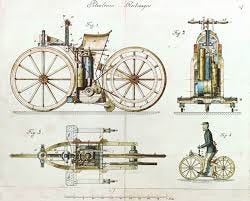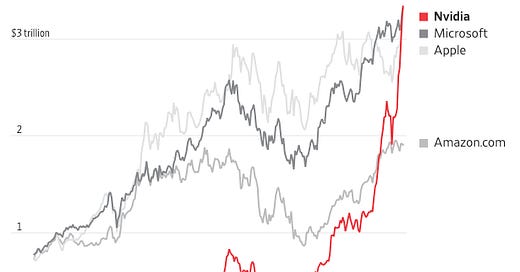
Discover more from Knowledge Problem
Social and Physical Theories of Technological Stagnation
Is Vaclav Smil right about the physical limitations to innovation?
Images from the original Daimler-Benz patent
Among those who believe that technological change has stagnated, there are two broad categories. One social/institutional theory of stagnation, often associated with Peter Thiel, claims that the world has entered a period of technological stagnation due to avoidable social and institutional factors. Thiel and others in this camp argue that societies have chosen safety, regulation, and risk avoidance over the potential rewards of groundbreaking innovations. These critics suggest that the current technological landscape—dominated by software and digital technology—lacks the world-changing impact of past advancements such as nuclear energy or space exploration.
A contrasting physical theory of stagnation, championed by Vaclav Smil, argues that technological stagnation is not a crisis but a return to the historical norm. Smil contends that the rapid technological leaps of the 19th and early 20th centuries were anomalies, and that current expectations of continuous breakthroughs are unrealistic. Smil is skeptical of overhyped promises like nuclear fusion, autonomous vehicles, and artificial intelligence, viewing them as examples of exaggerated optimism that fail to account for the complexities involved in real-world applications.
Earlier this week I read Jon Askonas' review essay, "Technological Stagnation is a Choice," in American Affairs (2023) of Vaclav Smil's book Invention and Innovation: A Brief History of Hype and Failure. Askonas, a political scientist at Catholic University of America reviewed the book with such depth and acuity that the essay itself is an outstanding and thoughtful piece of analysis. More than anyone else I've read recently, Askonas has both characterized the relationships between humans and technology well and provided useful and incisive critiques of Smil's analysis. Do go read his essay, yes, now, and then come back.
The famously-prolific Smil is well-known for his large, careful, detailed body of work on technology and its history, focusing in recent years on energy technologies and decarbonization. I first encountered Smil's work in the mid-2000s when I assigned a couple of chapters from his 2005 book, Creating the Twentieth Century: Technical Innovations of 1867-1914 and Their Lasting Impact, in my Western Economic History class at Northwestern University. His more recent works have narrowed the scope to focus on energy technologies and take a science and engineering perspective on the socio-technical questions of the benefits and costs associated with human uses of inanimate energy as a productivity-enhancing and innovation-creating source of work.
While recognizing the real obstacles to technological progress is crucial, societies must also be willing to allow inventors, entrepreneurs, founders, to take calculated risks, and to flourish in the future they must embrace policies that enable experimentation and innovation.
As with so many other topics recently, discussions of energy technologies, technological change, and their social effects have a binary quality—either unicorns and rainbows in the best of all worlds or the doom and gloom of technological stagnation. Smil helpfully provides well-informed details in his emphasis on energy technology transitions, and the fact that these transitions take time. He's been making this point for over a decade, for example in this 2014 Scientific American column:
Yet from 1990 to 2012 the world's energy from fossil fuels barely changed, down from 88 to 87 percent. In 2011 renewables generated less than 10 percent of the U.S. energy supply, and most of that came from “old” renewables, such as hydroelectric plants and burning wood waste from lumbering operations. After more than 20 years of highly subsidized development, new renewables such as wind and solar and modern biofuels such as corn ethanol have claimed only 3.35 percent of the country's energy supply.
The slow pace of this energy transition is not surprising. In fact, it is expected. In the U.S. and around the world, each widespread transition from one dominant fuel to another has taken 50 to 60 years. First came a change from wood to coal. Then from coal to oil. The U.S. is going through a third major energy transition right now, from coal and oil to natural gas. Between 2001 to 2012 America's coal consumption fell by 20 percent, and crude oil was down by 7 percent; at the same time, the consumption of natural gas rose by 14 percent. Yet even though natural gas is abundant, clean and affordable, it will be another decade or two before gas use overwhelms coal consumption, which still generates more than a third of U.S. electricity.
Renewables are not taking off any faster than the other new fuels once did, and there is no technical or financial reason to believe they will rise any quicker, in part because energy demand is soaring globally, making it hard for natural gas, much less renewables, to just keep up.
Note in hindsight that at least in electricity gas has overwhelmed coal consumption at the short end of his predicted 10-20 year time scale.
In his review, Askonas starts here, pointing out that Smil continues to argue that transitions take time, innovation takes a lot of work, failure is an inevitable part of the process, and utopian thinking is just that, Utopian. Smil is pushing back, hard, against innovation hype and the belief that exponential growth in clean energy technologies is just around the corner and will be ubiquitous. But Askonas is no credulous reader, and that's the value of his essay:
Smil begins from the notion that we live in a world beset by innovation hype and that a healthy dose of realism is just what the doctor ordered. But is innovation hype really the dominant tendency today? What is the meaning of the stories Smil recounts if you presume instead that a lack of concern for innovation and growth characterizes our society? Smil’s book was highly persuasive for me, though not in the way he might expect; I began sympathizing with his position and finished the book vehemently rejecting it. ... While one never wants to go toe-to-toe with Smil on the facts—the intellectual equivalent of facing George Foreman’s right hook—one can reexamine Smil’s careful narratives and find that they tell the story, not of failed innovation and of hype, but of human ingenuity and failure of imagination.
Askonas then describes the three case studies in innovation that form the bulk of the book—innovations that turn from welcome to undesirable (leaded gasoline, DDT), innovations that never meet their full potential (airships, nuclear fission), innovations that fail to arrive as promised, ever—and provides compelling, thoughtful alternate interpretations to Smil's while using his detailed history of technology and adding detail to it.
His discussion of Smil's analysis of leaded gasoline highlights the role of counterfactual analysis and the importance of working to identify causation, not just correlation. Leaded gasoline was invented because it solved the problem of incomplete combustion in internal combustion engines, which wasted fuel and thus created both additional expense and environmental pollution. The argument in the 1960s that leaded gasoline caused higher blood lead levels in children was based on correlation studies, not on randomized trials that could identify causation (and as Askonas tells it, the studies were not particularly well done). Askonas describes some causal studies that ascribe some share of responsibility for blood lead levels to gasoline, but not all of it.
The key insight here is that there are tradeoffs. An innovation that addresses some challenge and creates benefits can, and usually does, create unforeseeable costs or problems elsewhere. This is why asking the counterfactual question is important: what would have happened if leaded gasoline had never been invented? We'd have had some other pattern of environmental problems from the uncombusted gasoline, but we would also have lost other associated benefits:
Certainly, the elimination of leaded gasoline (alongside the deployment of catalytic convertors) has been an important victory for public health. But the vast majority of the hazards of leaded gasoline have been associated with the massive uptake of automobiles globally, and in the United States after the 1950s. What would have happened if leaded gasoline had been banned in those critical early years, 1921–50? Banning leaded gasoline at the outset of the automotive revolution would have lead [sic] to higher costs, worse efficiency, and worse pollution from the start. Worse, it likely would have set the advent of aviation back by decades: achieving the octane required for airplane engines without TEL is enormously expensive, and was initially impossible. The most common aviation gasoline used in propeller planes contains TEL to this day. In other words, even a simple counterfactual reveals that preemptively banning leaded gasoline would have substantially retarded innovation. It was precisely the massive success of automobiles and aviation that created the surplus and the incentives to solve the technical problem of fuel additives like tetraethyl lead!
I relay all of this detail not to defend leaded gasoline in particular but to call into question the replacement of one fantasy by another. What has been presented as a slam-dunk case turns out to be a nuanced and complicated story with, at best, an unsettling counterfactual.
Askonas proceeds to analyze Smil's other categories of (over)hyped technologies, and I highly recommend reading those details both to learn more of the histories of these important technologies and research endeavors and to work through the logic of his critique of Smil's interpretation.
Overall, Askonas makes the large and important point that "what drives innovation for all of society forward are not the details, but the concrete belief that, with the application of curiosity, drive, and capital, it is possible to build transformative technology." Yes, Smil is correct to be skeptical of futurists and hucksters promising fast, frictionless change. But the economic history of technology and economic growth shows, over and over and over again, that technological change is a combination of iterative, combinatorial changes and big, discrete, punctuated changes. Both of these processes, innovation and invention, require the application of curiosity, drive, and capital. Curiosity and drive are often accompanied in the mindsets of entrepreneurs by visions of the potential to create transformative technology; Smil himself highlighted examples in his 2005 book, such as Edison, Westinghouse, Bell, Daimler, Benz, ... but Smil sees that fruitful period as an historical anomaly, not to be repeated.
Askonas quotes Alfred Hirschmann on the importance for such transformative change of the "heedless and unmerited optimism (one might even say hype) of committed founders and doers" who believe they can deliver on such technological change and who are willing to work tirelessly to do so. They attract investors who take risks in expectation of returns; sometimes you get the bear, sometimes the bear gets you.
I also think Smil's dismissal of hype runs into the pervasive problem of Type I error. He rejects hype when he should fail to reject it/when the hype is true; not all instances of optimism are hype. By falsely diagnosing optimism as hype Smil makes himself myopic and unable to acknowledge the potential for truly transformational technologies like those he wrote about in the 19th century. Smil sees that technological florescence as an historical anomaly that cannot be repeated.
But how do we know if it can be repeated if we don't keep looking, working, trying, striving?
To be fair to Smil, though, predicting what will be hype and what will be transformative is impossible. He need not predict; he can acknowledge that technological change is a system of punctuated equilibria, and the underlying complex and combinatorial structure of invention and innovation, when interacted with human curiosity, drive, and vision will create transformative technologies. We just cannot know exactly when or what form they will take. That claim is still consistent with his physical theory of stagnation, that invention is costly and time-consuming so we should prioritize incremental innovation, but if he wants to limit technological change to innovation, he's foreclosing the possibility of transformative change in a kind of precautionary move to innoculate societies against the cost of hype.
Askonas ends up very much in the same place that I do. While recognizing the real obstacles to technological progress is crucial, societies must also be willing to allow inventors, entrepreneurs, founders, to take calculated risks, and to flourish in the future they must embrace policies that enable experimentation and innovation.
Technological progress is not inevitable, but rather a product of social choices. I'm not exactly in the same place as Thiel because I wouldn't go so far as to say that we have technological stagnation, although I agree that the primary limitations on progress are social and policy factors. I'm also not in the same place as Smil even though I think he's absolutely correct that the clean energy transition will take decades, much longer than many hope and wish. Even though technological change is costly and time-consuming, I think Smil is mistaken to say that the vibrant creativity of the 19th century cannot be repeated.
The tension between risk and reward, stagnation and progress, will shape the future trajectory of technological development and its impact on global society. Ultimately, Askonas argues, technological stagnation is a choice—a result of the priorities and policies that societies choose to adopt. Stagnation is a choice.














What strikes me about the 1867-1914 period is how much the technological revolution of that time coincided with a huge flourishing of the arts and humanities and a dramatic improvement to the built environment that was driven by art and design, not only by technology. The music, visual art, architecture, and literature of that period all contain so much that remains outstanding and canonical today, that was impossible to do before and has rarely been done since. And that period also saw the rise of the streetcar suburb, one of the most pleasant forms of residential community ever devised, and arguably much pleasanter than any such innovation that came after it.
If we believe that the causation was not all one way-- that there were common cultural roots of the humanistic and technological advances of that period-- that should strengthen the view that stagnation is a choice.
I interviewed Askonas a few months ago: https://open.substack.com/pub/mupetblast/p/dry-hyphen-olympics-show-transcript-4fa?utm_source=share&utm_medium=android&r=1iiul